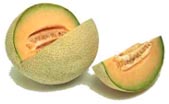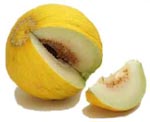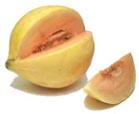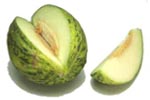
Many melons originated in the Middle East and gradually spread its
popularity across Europe. Ancient Egyptians and Romans enjoyed cantaloupes
or muskmelons. Melon seeds were transported to the United States by
Columbus and eventually cultivated by Spanish explorers in California.
Most people don’t know that melons are in the same gourd family as
squashes and cucumbers. Most melons have similar structure to winter
squash with thick flesh and inner seed-filled midsection. So what’s the
difference between melons and squashes? It’s the way that they’re used.
Squashes are considered vegetables, while melons are known as fruits with
sweet and juicy flavor.
Melons are a good source of vitamin C and potassium. They have high water
content are relatively low in calories, and also fat and cholesterol free.
|
Cantaloupe |
Serving size
1/2 cup, diced (78g)
|
Amounts Per Serving |
% Daily
Value |
| Calories
25 |
|
| Calories
from Fat 0 |
|
| Total Fat 0g |
0% |
| Saturated
Fat 0g |
0% |
| Cholesterol
0mg |
0% |
| Sodium
10mg |
0% |
| Total
Carbohydrate 6g |
2% |
|
Dietary Fiber 1g |
4% |
|
Sugars 6g |
|
| Protein 1g |
|
| Vitamin A |
50% |
| Vitamin C |
50% |
| Calcium |
0% |
| Iron |
0% |
* Percent Daily Values are based on a
2,000 calorie diet. |
|
|

|
|
Honeydew |
Serving
size 1/2 cup, diced (85g)
|
Amounts Per Serving |
% Daily
Value |
| Calories
30 |
|
| Calories
from Fat 0 |
|
| Total Fat 0g |
0% |
| Saturated
Fat 0g |
0% |
| Cholesterol
0mg |
0% |
| Sodium
15mg |
1% |
| Total
Carbohydrate 8g |
3% |
|
Dietary Fiber 1g |
4% |
|
Sugars 7g |
|
| Protein 0g |
|
| Vitamin A |
0% |
| Vitamin C |
25% |
| Calcium |
0% |
| Iron |
0% |
* Percent Daily Values are based on a
2,000 calorie diet. |
|
|
Melon varieties are now endless! Cantaloupe, honeydew, and watermelon are
the most well known varieties. Lookout for more unusual melons at your local
supermarket or farmer’s market for a different and tasty sweet treat!

|
Cantaloupe
Actually called a muskmelon, this familiar fruit with orange flesh and khaki
netted colored skin provides the most beta-carotene in the entire melon
family. Select melons that are slightly golden with a light fragrant smell
(an indication of its ripeness). Cantaloupe is typically available
year-round, with a June through August peak season. |
 |
Casaba
Unlike the other melons, casaba melons do not have an aroma. This is a large
melon that is pale yellow when ripe and has white flesh with a sweet taste.
This melon peaks in the fall, but starts showing up in markets in July
through December. |
 |
Crenshaw
These melons can weigh up to ten pounds and deliver a unique sweet and spicy
flavor. They are a hybrid between the casaba and Persian melon with a
yellowish skin and salmon colored flesh. Peak season for Crenshaw melons is
August through September, with the fruit season beginning in July and ending
in October. |
 |
Honeydew
The sweetest of all the melons and averaging five to six pounds, honeydew
melons have a creamy yellow rind when ripe and pale green flesh. It’s best
from June through October, but is available year round. |
 |
Persian
This melon is quite similar to the Cantaloupe, but it slightly larger in
size, has a reener rind, and on the outside it has finer netting. Persian melons
are peak in August and September with the season beginning in June and
ending November. |
 |
Santa Claus
This melon is also known as the Christmas melon because it peaks during the
month of December. This variety is similar to the watermelon with the green
and gold stripes, but is about a foot long and isn’t as sweet as the other
melons. |
 |
Sharlyn
This melon tastes like a cantaloupe and honeydew combined. Sharlyn melons
are sweet with netted outer layer, greenish-orange rind, and white flesh.
The availability varies, so check your local supermarkets and farmer’s
market. |
In general, melons should be shaped according to their variety. For
example, cantaloupes should be round, etc. In addition, melons should not
have cracks, soft spots, or dark bruises. You should look for a clean and
smooth break at the stem and for most mature melons have a fruity
fragrance (if not chilled).
Keep uncut melons at room temperature for two to four days or until
fully ripe, then refrigerate for up to 5 days. Refrigerate cut up melon in
a covered container up to 3 days. Remember that cut melons are aromatic
and their smell will penetrate other foods.
Melon preparation is easy! Always wash melons in warm soapy water
before cutting to get rid of any impurity on the rind that might be
carried from the knife blade to the flesh. Simply cut the melon in half
and scoop out the seeds and strings. Melons can be cut into halves,
quarters, wedges, cubes, or scooped into balls with a melon baller. Most
melons will benefit from a squeeze of lemon or lime juice to enhance the
flavor and served at room temperature.
Cantaloupe Salsa
Makes 4 servings
Each serving equals 1/2 cup of fruit or vegetables
Source: PBH/Del Monte Fresh Produce Co.
Ingredients
½ cantaloupe (large, ripe)
¾ cup red bell pepper, finely diced
¼ cup cilantro, finely chopped
3 Tbsp scallions, finely chopped
Juice of 1 lime
Pinch of salt and hot pepper flakes
Remove seeds and rind from cantaloupe. (You should have approximately ½
pound cantaloupe flesh.) Chop cantaloupe into very small dice. Put in
bowl. Add diced red pepper, cilantro, scallions and lime juice. Stir. Add
pinch of salt and pepper flakes. Chill. Serve with grilled chicken, fish
or steaks.
Nutritional Analysis: Calories 75, Fat 1g, Calories from Fat 8%,
Cholesterol 0mg, Fiber 2g, Sodium 23mg.
Find more in our
recipe database!
|



